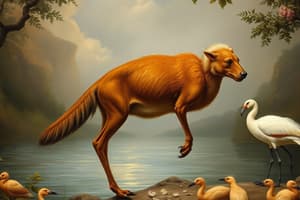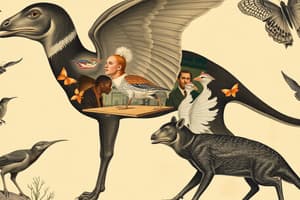Podcast
Questions and Answers
What is the focus of ornithology?
What is the focus of ornithology?
- Study of birds (correct)
- Study of insects
- Study of reptiles
- Study of mammals
Which of the following represents the correct hierarchy in the system of classification?
Which of the following represents the correct hierarchy in the system of classification?
- Class > Phylum > Domain
- Domain > Kingdom > Phylum (correct)
- Order > Family > Class
- Species > Genus > Order
Which of the following is NOT one of the four major categories of biological macromolecules?
Which of the following is NOT one of the four major categories of biological macromolecules?
- Lipids
- Nucleic Acids
- Electrolytes (correct)
- Carbohydrates
What defines growth in living organisms?
What defines growth in living organisms?
How do organisms primarily respond to environmental changes?
How do organisms primarily respond to environmental changes?
What is the requirement for organisms to survive and grow?
What is the requirement for organisms to survive and grow?
What defines a unicellular organism?
What defines a unicellular organism?
What does chemical uniqueness in organisms refer to?
What does chemical uniqueness in organisms refer to?
What is one fundamental property of life that ensures a species continues to exist?
What is one fundamental property of life that ensures a species continues to exist?
Which process allows organisms to respond to their environment and sustain existence?
Which process allows organisms to respond to their environment and sustain existence?
Which scientist is credited with perfecting the simple microscope and discovering bacteria?
Which scientist is credited with perfecting the simple microscope and discovering bacteria?
What did Robert Brown observe in cells that contributed to our understanding of cell structure?
What did Robert Brown observe in cells that contributed to our understanding of cell structure?
What did Felix Dujardin discover about cells in 1835?
What did Felix Dujardin discover about cells in 1835?
Why is energy expenditure essential for organisms?
Why is energy expenditure essential for organisms?
Which term did Johannes Purkinje use to refer to the substances within cells?
Which term did Johannes Purkinje use to refer to the substances within cells?
What is the significance of organisms evolving over time?
What is the significance of organisms evolving over time?
What is the primary function of the Golgi apparatus?
What is the primary function of the Golgi apparatus?
Which component of the cell is primarily involved in cellular respiration?
Which component of the cell is primarily involved in cellular respiration?
How do lysosomes contribute to cellular digestion?
How do lysosomes contribute to cellular digestion?
What is a primary characteristic of vacuoles in plant cells?
What is a primary characteristic of vacuoles in plant cells?
What part of the mitochondria increases the surface area for reactions?
What part of the mitochondria increases the surface area for reactions?
What happens to a cell placed in a hypotonic solution?
What happens to a cell placed in a hypotonic solution?
What is the semifluid material found within the nucleus called?
What is the semifluid material found within the nucleus called?
Which statement accurately describes active transport?
Which statement accurately describes active transport?
Which component of a cell membrane contributes to making it less permeable to water-soluble substances?
Which component of a cell membrane contributes to making it less permeable to water-soluble substances?
What is the purpose of phagocytosis?
What is the purpose of phagocytosis?
What is TRUE about peripheral proteins in cell membranes?
What is TRUE about peripheral proteins in cell membranes?
What occurs during exocytosis?
What occurs during exocytosis?
What is known as protoplasm?
What is known as protoplasm?
What structure acts as a molecular 'fingerprint' for cell recognition and interaction?
What structure acts as a molecular 'fingerprint' for cell recognition and interaction?
Which part of the eukaryotic cell is responsible for regulating movement of materials in and out of the cell?
Which part of the eukaryotic cell is responsible for regulating movement of materials in and out of the cell?
Which of the following describes the role of the nucleus in a cell?
Which of the following describes the role of the nucleus in a cell?
What characteristic of phospholipids contributes to the formation of the cell membrane's bilayer structure?
What characteristic of phospholipids contributes to the formation of the cell membrane's bilayer structure?
What characterizes cytoplasm?
What characterizes cytoplasm?
What component of the cytoplasm is the semifluid portion where organelles are suspended?
What component of the cytoplasm is the semifluid portion where organelles are suspended?
Pinocytosis can be described as which of the following?
Pinocytosis can be described as which of the following?
Which of the following is NOT a function of membrane proteins?
Which of the following is NOT a function of membrane proteins?
Flashcards
What is ornithology?
What is ornithology?
The study of birds.
What is protozoology?
What is protozoology?
The study of single-celled eukaryotic organisms.
What is binomial nomenclature?
What is binomial nomenclature?
A two-part naming system used to classify organisms, consisting of the genus and species names.
Describe the system of hierarchical classification.
Describe the system of hierarchical classification.
Signup and view all the flashcards
What are the four major macromolecules found in living organisms?
What are the four major macromolecules found in living organisms?
Signup and view all the flashcards
Define unicellular organisms.
Define unicellular organisms.
Signup and view all the flashcards
Define multicellular organisms.
Define multicellular organisms.
Signup and view all the flashcards
What is the concept of responsiveness in living organisms?
What is the concept of responsiveness in living organisms?
Signup and view all the flashcards
Explain the concept of growth in living organisms.
Explain the concept of growth in living organisms.
Signup and view all the flashcards
What is nourishment in living organisms?
What is nourishment in living organisms?
Signup and view all the flashcards
Define the concept of reproduction in living organisms.
Define the concept of reproduction in living organisms.
Signup and view all the flashcards
What is the concept of energy expenditure in living organisms?
What is the concept of energy expenditure in living organisms?
Signup and view all the flashcards
What is excretion in living organisms?
What is excretion in living organisms?
Signup and view all the flashcards
Explain the concept of evolution in living organisms.
Explain the concept of evolution in living organisms.
Signup and view all the flashcards
Who was Robert Hooke and what was his contribution?
Who was Robert Hooke and what was his contribution?
Signup and view all the flashcards
Who was Antonie van Leeuwenhoek and what was his contribution?
Who was Antonie van Leeuwenhoek and what was his contribution?
Signup and view all the flashcards
Who was Robert Brown and what was his contribution?
Who was Robert Brown and what was his contribution?
Signup and view all the flashcards
Who was Felix Dujardin and what was his contribution?
Who was Felix Dujardin and what was his contribution?
Signup and view all the flashcards
Who was Johannes Purkinje and what was his contribution?
Who was Johannes Purkinje and what was his contribution?
Signup and view all the flashcards
What is the nucleus of a eukaryotic cell?
What is the nucleus of a eukaryotic cell?
Signup and view all the flashcards
What is cytoplasm?
What is cytoplasm?
Signup and view all the flashcards
What is the cell membrane?
What is the cell membrane?
Signup and view all the flashcards
What is the phospholipid bilayer in cell membranes?
What is the phospholipid bilayer in cell membranes?
Signup and view all the flashcards
What is cholesterol's role in cell membranes?
What is cholesterol's role in cell membranes?
Signup and view all the flashcards
What are intrinsic proteins in cell membranes?
What are intrinsic proteins in cell membranes?
Signup and view all the flashcards
What are peripheral proteins in cell membranes?
What are peripheral proteins in cell membranes?
Signup and view all the flashcards
What is the glycocalyx in cell membranes?
What is the glycocalyx in cell membranes?
Signup and view all the flashcards
What is passive transport in cell membranes?
What is passive transport in cell membranes?
Signup and view all the flashcards
What is active transport in cell membranes?
What is active transport in cell membranes?
Signup and view all the flashcards
What is endocytosis?
What is endocytosis?
Signup and view all the flashcards
What is phagocytosis?
What is phagocytosis?
Signup and view all the flashcards
What is pinocytosis?
What is pinocytosis?
Signup and view all the flashcards
What is exocytosis?
What is exocytosis?
Signup and view all the flashcards
What are lysosomes?
What are lysosomes?
Signup and view all the flashcards
What are mitochondria?
What are mitochondria?
Signup and view all the flashcards
What are vacuoles?
What are vacuoles?
Signup and view all the flashcards
Study Notes
Ornithology and Protozoology
- Ornithology is the study of birds.
- Protozoology is the study of protozoa.
System of Classification
- Binomial nomenclature uses two-part scientific names (e.g., Perissodus microlepis).
- Hierarchical classification ranks organisms as Domain > Kingdom > Phylum > Class > Order > Family > Genus > Species.
Fundamental Properties of Life
- Organisms exhibit chemical uniqueness and are composed of four major macromolecules: proteins, carbohydrates, lipids, and nucleic acids.
- All living organisms are made up of cells: unicellular organisms (e.g., amoeba) versus multicellular organisms (e.g., humans).
- Organisms respond to internal and external stimuli.
- Growth is defined as an increase in mass; it requires the intake of substances from the environment.
- Nourishment is crucial for survival, growth, and development, coming from food, sunlight, or nutrients.
- Reproduction is essential for the continuation of species, involving the transmission of genetic material.
- Energy is expended by organisms to carry out vital processes (movement, growth, reproduction, maintaining homeostasis).
- Excretion of wastes and toxins is a necessary life function.
- Organisms evolve over time through genetic adaptations for survival.
History of the Microscope
- Robert Hooke (1665) improved the compound microscope and named cells after observing cork.
- Antonie van Leeuwenhoek perfected the simple microscope and discovered bacteria and protozoa, termed "animalcules."
- Robert Brown (1831) discovered the nucleus in cells.
- Felix Dujardin (1835) revealed that cells contain thick fluid.
- Johannes Purkinje (1839) introduced the term "protoplasm" for cell contents.
Eukaryotic Cells
- Three basic parts of eukaryotic cells: nucleus, cytoplasm, and cell membrane.
- Cytoplasm is a semifluid portion outside the nucleus containing organelles.
Cell Membranes: Structure
- Phospholipid bilayer consists of hydrophilic heads and hydrophobic tails.
- Cholesterol within the membrane enhances stability and reduces permeability for water-soluble substances.
- Membrane proteins include peripheral proteins (surface-attached) and intrinsic proteins (embedded within the membrane).
- Glycocalyx, formed by glycoproteins and glycolipids, serves as a molecular "fingerprint" for cell recognition.
Cell Membranes: Functions
- Cell membranes regulate the movement of materials in and out of the cell.
- They separate the cell's interior from the external environment.
Types of Solutions
- Hypotonic solution: lower solute concentration outside the cell prompts water to move in, potentially causing the cell to swell or burst.
Transport Mechanisms
- Active transport requires a protein carrier and energy (ATP), moving molecules from lower to higher concentrations.
- Bulk transport includes:
- Endocytosis: engulfing particles and molecules.
- Phagocytosis: ingestion of solid particles.
- Pinocytosis: ingestion of fluids.
- Exocytosis: secretion of substances via vesicles merging with the membrane.
Cytoplasm, Organelles, and Cellular Components
- Cytoplasm is the gelatinous content within the cell membrane, comprising molecules and organelles.
- Nucleus serves as the cell's control center, housing nucleoplasm and orchestrating protein modification and transport.
- Lysosomes are membrane-bound organelles containing digestive enzymes to break down organic molecules.
- Mitochondria are double-membrane-bound organelles responsible for cellular respiration and energy conversion.
- Vacuoles in plant and animal cells store water, food, and waste; they play significant roles in plant cells.
Studying That Suits You
Use AI to generate personalized quizzes and flashcards to suit your learning preferences.




